Exercises (2231)
Adduction and abduction of the leg in standing position (left) ► adduction / abduction
Power
Individual work


The foot loop of the cable pulley is attached around the training leg. In a standing position, to the side of the cable pulley, the leg is pulled away against the weight and returned in a controlled manner.
Starting position:
- Stand upright to the side of the machine.
- Foot loop on the ankle of the left leg positioned closer to the machine.
End position:
- Pull your training leg in towards your body (legs crossed).
Attention:
The upper body and hips remain stable (tighten your stomach).
1 weight tower/machine ► Cable pulley (deep)
Adduction and abduction of the leg in standing position (right) ► adduction / abduction
Power
Individual work
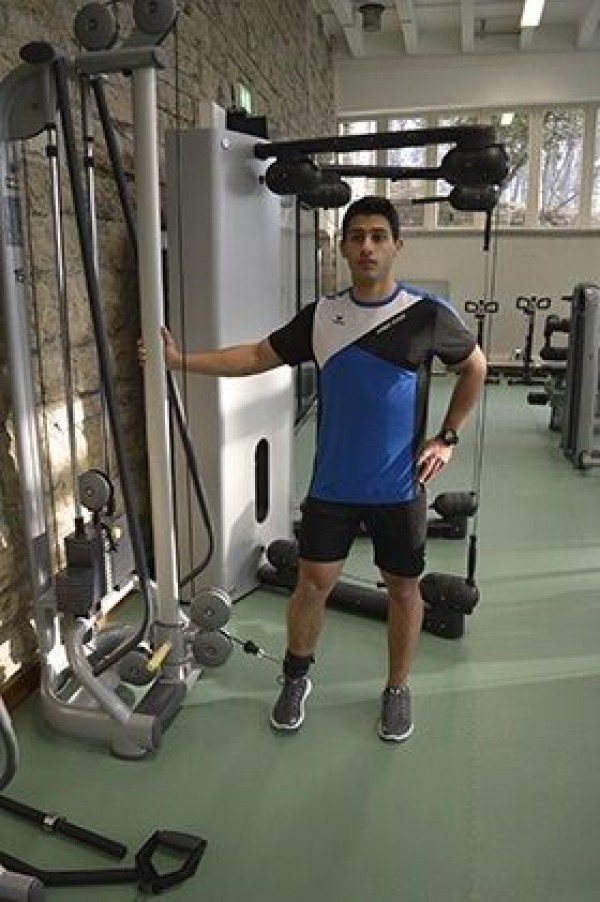

The foot loop of the cable pulley is attached around the training leg. In a standing position, to the side of the cable pulley, the leg is pulled away against the weight and returned in a controlled manner.
Starting position:
- Stand upright to the side of the machine.
- Foot loop on the ankle of the right leg positioned closer to the machine.
End position:
- Pull your training leg in towards your body (legs crossed).
Attention:
The upper body and hips remain stable (tighten your stomach).
1 weight tower/machine ►Cable pulley (deep)
Adduction and abduction of a leg in lateral position (left)
Power
Individual work
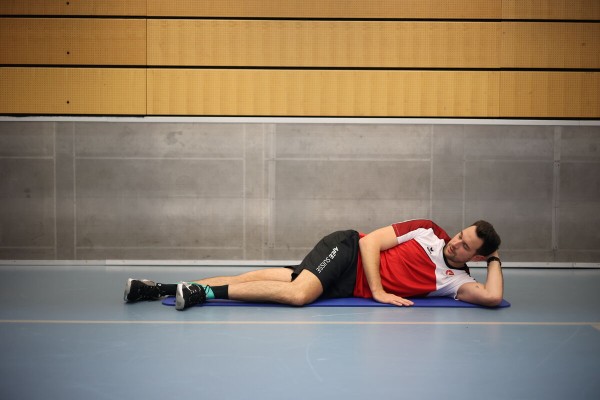
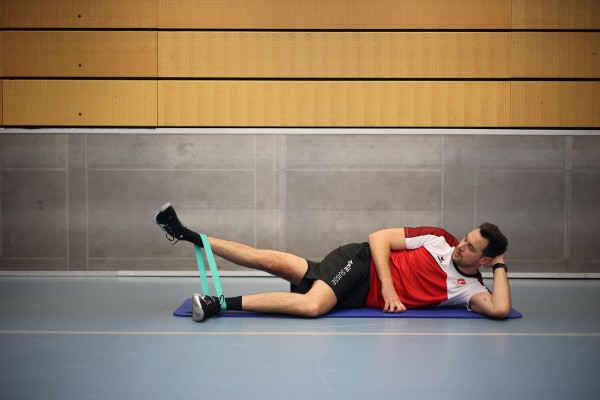
Position on the left side of the body, with the lower straight leg pointing backwards as an extension of the body, the upper slightly bent leg is placed over the lower leg so that the knee, lower leg (also pointing backwards) and the inner instep of the foot are also placed on the floor. An elasticated band is stretched between the legs (place the band around the ankles). The lower arm supports the head, the upper bent arm supports the upper body by placing the hand on the floor at the level of the navel. From this position, raise the lower (stretched) leg (stretch/stretch the band further) and lower it back to the starting position.
Attention:
For greater intensity, do not lower the training leg completely.
Lighten:
Choose an elastic band with less resistance.
Harden:
Choose an elastic band with greater resistance.
1 mini-band
Adduction and abduction of a leg in lateral position (right)
Power
Individual work
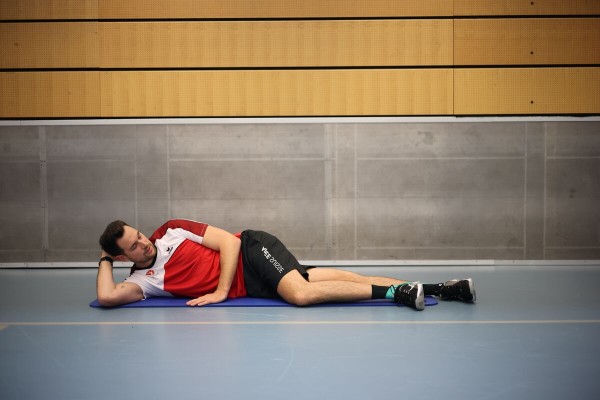
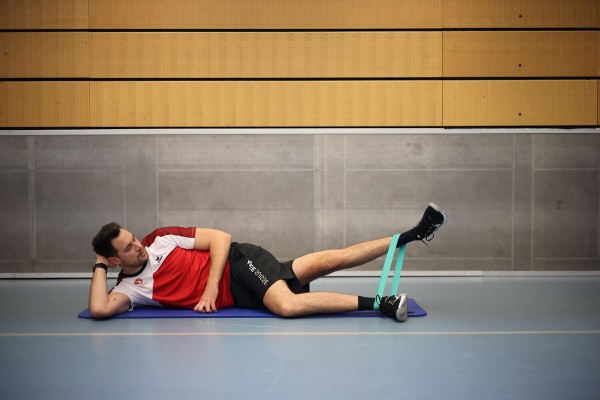
Position on the right side of the body, with the lower straight leg pointing backwards as an extension of the body, the upper slightly bent leg is placed over the lower leg so that the knee, the lower leg (also pointing backwards) and the inner instep of the foot are also placed on the floor. An elasticated band is stretched between the legs (place the band around the ankles). The lower arm supports the head, the upper bent arm supports the upper body by placing the hand on the floor at the level of the navel. From this position, raise the lower (stretched) leg (stretch/stretch the band further) and lower it back to the starting position.
Attention:
For greater intensity, do not lower the training leg completely.
Lighten:
Choose an elastic band with less resistance.
Harden:
Choose an elastic band with greater resistance.
1 mini-band
Air-Bike
Power
Individual work


At first glance, the air bike looks similar to a bicycle ergometer or a spinning bike. However, the difference lies in the fact that not only the legs but also the arm and core muscles are used, as these are required for the movement of the air bike. As the handles are pulled along with the hands, the legs and arms move simultaneously.
As the name suggests, the special feature of the air bike is the air resistance. The intensity of the training is regulated solely by the air resistance. The faster the pedalling movement, the greater the air resistance, and therefore the more strenuous the training. On the one hand, this ensures intuitive operation of the device, which is an additional fun factor for many athletes, and on the other hand, the air resistance ensures that the joints are protected.
1 Air-Bike
Air-Bike (m: 1000m/1km - 30k; f: 800m - 21k)
Power
Individual work


At first glance, the air bike looks similar to a bicycle ergometer or a spinning bike. However, the difference lies in the fact that not only the legs but also the arm and core muscles are used, as these are required for the movement of the air bike. As the handles are pulled along with the hands, the legs and arms move simultaneously.
As the name suggests, the special feature of the air bike is the air resistance. The intensity of the training is regulated solely by the air resistance. The faster the pedalling movement, the greater the air resistance, and therefore the more strenuous the training. On the one hand, this ensures intuitive operation of the device, which is an additional fun factor for many athletes, and on the other hand, the air resistance ensures that the joints are protected.
1 Air-Bike
Air-Bike (m: 1600m/1.6km/1 Mile - 45k; f: 1200m/1.2km - 30k)
Power
Individual work
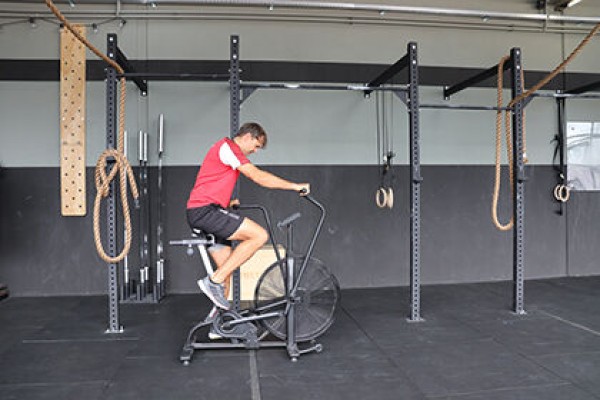
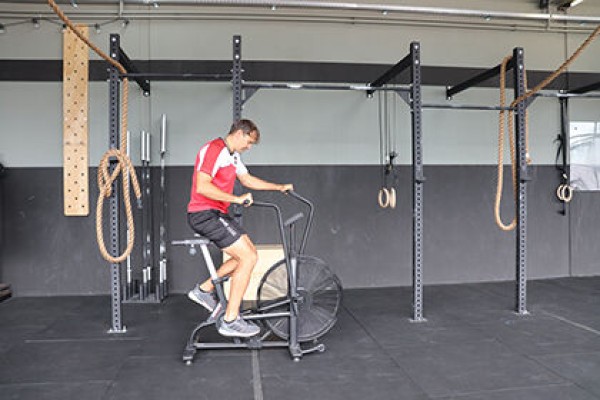
At first glance, the air bike looks similar to a bicycle ergometer or a spinning bike. However, the difference lies in the fact that not only the legs but also the arm and core muscles are used, as these are required for the movement of the air bike. As the handles are pulled along with the hands, the legs and arms move simultaneously.
As the name suggests, the special feature of the air bike is the air resistance. The intensity of the training is regulated solely by the air resistance. The faster the pedalling movement, the greater the air resistance, and therefore the more strenuous the training. On the one hand, this ensures intuitive operation of the device, which is an additional fun factor for many athletes, and on the other hand, the air resistance ensures that the joints are protected.
1 Air-Bike
Air-Bike (m: 2000m/2km - 60k; f: 1600m/1.6km/1 Mile - 42k)
Power
Individual work

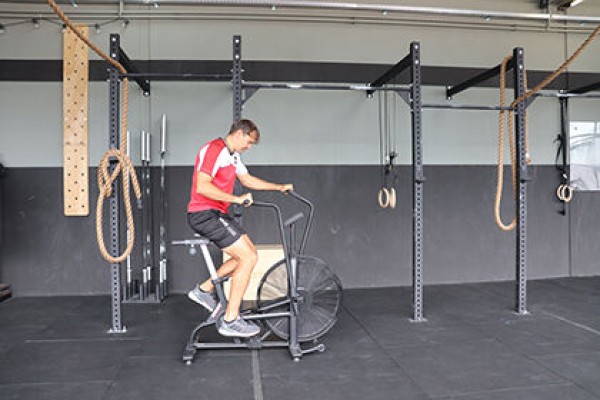
At first glance, the air bike looks similar to a bicycle ergometer or a spinning bike. However, the difference lies in the fact that not only the legs but also the arm and core muscles are used, as these are required for the movement of the air bike. As the handles are pulled along with the hands, the legs and arms move simultaneously.
As the name suggests, the special feature of the air bike is the air resistance. The intensity of the training is regulated solely by the air resistance. The faster the pedalling movement, the greater the air resistance, and therefore the more strenuous the training. On the one hand, this ensures intuitive operation of the device, which is an additional fun factor for many athletes, and on the other hand, the air resistance ensures that the joints are protected.
1 Air-Bike
Air-Bike (m: 2500m/2.5km - 75k; f: 2000m/2km - 50k)
Power
Individual work


At first glance, the air bike looks similar to a bicycle ergometer or a spinning bike. However, the difference lies in the fact that not only the legs but also the arm and core muscles are used, as these are required for the movement of the air bike. As the handles are pulled along with the hands, the legs and arms move simultaneously.
As the name suggests, the special feature of the air bike is the air resistance. The intensity of the training is regulated solely by the air resistance. The faster the pedalling movement, the greater the air resistance, and therefore the more strenuous the training. On the one hand, this ensures intuitive operation of the device, which is an additional fun factor for many athletes, and on the other hand, the air resistance ensures that the joints are protected.
1 Air-Bike
Air-Bike (m: 250m - 7k; f: 200m - 5k)
Power
Individual work


At first glance, the air bike looks similar to a bicycle ergometer or a spinning bike. However, the difference lies in the fact that not only the legs but also the arm and core muscles are used, as these are required for the movement of the air bike. As the handles are pulled along with the hands, the legs and arms move simultaneously.
As the name suggests, the special feature of the air bike is the air resistance. The intensity of the training is regulated solely by the air resistance. The faster the pedalling movement, the greater the air resistance, and therefore the more strenuous the training. On the one hand, this ensures intuitive operation of the device, which is an additional fun factor for many athletes, and on the other hand, the air resistance ensures that the joints are protected.
1 Air-Bike
Air-Bike (m: 300m - 10k; w: 250m - 6k)
Power
Individual work


At first glance, the air bike looks similar to a bicycle ergometer or a spinning bike. However, the difference lies in the fact that not only the legs but also the arm and core muscles are used, as these are required for the movement of the air bike. As the handles are pulled along with the hands, the legs and arms move simultaneously.
As the name suggests, the special feature of the air bike is the air resistance. The intensity of the training is regulated solely by the air resistance. The faster the pedalling movement, the greater the air resistance, and therefore the more strenuous the training. On the one hand, this ensures intuitive operation of the device, which is an additional fun factor for many athletes, and on the other hand, the air resistance ensures that the joints are protected.
1 Air-Bike
Air-Bike (m: 4000m/4km - 120k; f: 3200m/3.2km/2 Miles - 100k)
Power
Individual work


At first glance, the air bike looks similar to a bicycle ergometer or a spinning bike. However, the difference lies in the fact that not only the legs but also the arm and core muscles are used, as these are required for the movement of the air bike. As the handles are pulled along with the hands, the legs and arms move simultaneously.
As the name suggests, the special feature of the air bike is the air resistance. The intensity of the training is regulated solely by the air resistance. The faster the pedalling movement, the greater the air resistance, and therefore the more strenuous the training. On the one hand, this ensures intuitive operation of the device, which is an additional fun factor for many athletes, and on the other hand, the air resistance ensures that the joints are protected.
1 Air-Bike
Air-Bike (m: 500m - 15k; f: 400m - 10k)
Power
Individual work
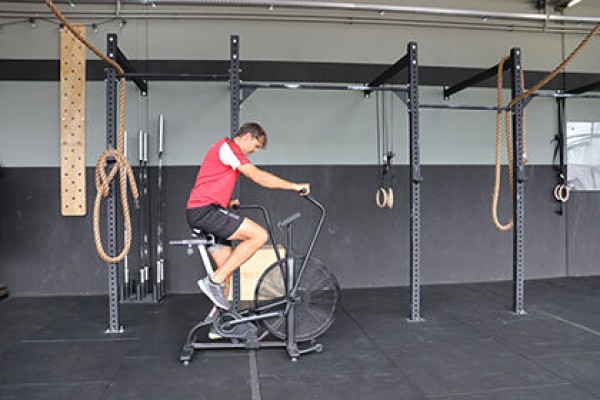

At first glance, the air bike looks similar to a bicycle ergometer or a spinning bike. However, the difference lies in the fact that not only the legs but also the arm and core muscles are used, as these are required for the movement of the air bike. As the handles are pulled along with the hands, the legs and arms move simultaneously.
As the name suggests, the special feature of the air bike is the air resistance. The intensity of the training is regulated solely by the air resistance. The faster the pedalling movement, the greater the air resistance, and therefore the more strenuous the training. On the one hand, this ensures intuitive operation of the device, which is an additional fun factor for many athletes, and on the other hand, the air resistance ensures that the joints are protected.
1 Air-Bike
Air-Bike (m: 650m - 20k; f: 500m - 13k)
Power
Individual work


At first glance, the air bike looks similar to a bicycle ergometer or a spinning bike. However, the difference lies in the fact that not only the legs but also the arm and core muscles are used, as these are required for the movement of the air bike. As the handles are pulled along with the hands, the legs and arms move simultaneously.
As the name suggests, the special feature of the air bike is the air resistance. The intensity of the training is regulated solely by the air resistance. The faster the pedalling movement, the greater the air resistance, and therefore the more strenuous the training. On the one hand, this ensures intuitive operation of the device, which is an additional fun factor for many athletes, and on the other hand, the air resistance ensures that the joints are protected.
1 Air-Bike
Air-Bike (m: 750m - 22k; f: 600m - 15k)
Power
Individual work


At first glance, the air bike looks similar to a bicycle ergometer or a spinning bike. However, the difference lies in the fact that not only the legs but also the arm and core muscles are used, as these are required for the movement of the air bike. As the handles are pulled along with the hands, the legs and arms move simultaneously.
As the name suggests, the special feature of the air bike is the air resistance. The intensity of the training is regulated solely by the air resistance. The faster the pedalling movement, the greater the air resistance, and therefore the more strenuous the training. On the one hand, this ensures intuitive operation of the device, which is an additional fun factor for many athletes, and on the other hand, the air resistance ensures that the joints are protected.
1 Air-Bike
Acro demonstration
Partner acrobatics
Group work
2-4 group

The participants put together a small demonstration of different figures in (small) groups and show them to the sports leader (and the whole group).
Variant:
The groups judge each other's demonstrations and thus determine a winning group.
No material required
Raising of the arms in prone position ► prone A hold
Power
Lie on your stomach with your forehead resting on a folded cloth, feet shoulder-width apart, arms pointing diagonally backwards (A position) in extension of the body to each side. From this position, pull the shoulder blades together and raise the arms until the elbows are at shoulder height and the arms are parallel to the floor (palms facing inwards). Keep your arms straight and hold the position.
Attention:
Only the arms should be raised, nothing else - aim to isolate the upper back.
Harden:
Hold additional weight in your hands or on your arms.
2 weight cuffs/2 weight balls/dumbbells ► Make the exercise more difficult (additional weight)
Raising of the arms in prone position ► prone A raise hold
Power
Lie on your stomach with your upper body slightly raised, feet shoulder-width apart, arms pointing diagonally backwards (A position) in extension of the body to the respective side. From this position, pull your shoulder blades together and raise your arms until your elbows are at shoulder height and your arms are parallel to the floor (palms facing inwards). Keep your arms straight and hold the position.
Attention:
Only the arms should be raised, nothing else - aim to isolate the upper back.
Harden:
Hold additional weight in your hands or on your arms.
2 weight cuffs/2 weight balls/dumbbells ► Make the exercise more difficult (additional weight)
Raising of the arms in prone position ► prone I hold
Power
Lie on your stomach with your forehead resting on a folded cloth, feet shoulder-width apart, arms pointing forwards as an extension of your body (I position). From this position, pull the shoulder blades together and raise the arms until the elbows are at shoulder height and the arms are parallel to the floor (palms facing inwards). Keep your arms straight and hold the position.
Attention:
Only the arms should be raised, nothing else - aim to isolate the upper back.
Harden:
Hold additional weight in your hands or on your arms.
2 weight cuffs/2 weight balls/dumbbells ► Make the exercise more difficult (additional weight)
Raising of the arms in prone position ► prone I raise hold
Power
Lie on your stomach with your upper body slightly raised, feet shoulder-width apart, arms pointing forwards as an extension of your body (I position). From this position, pull your shoulder blades together and raise your arms until your elbows are at shoulder height and your arms are parallel to the floor (palms facing inwards). Keep your arms straight throughout the entire movement. Keep your arms straight and hold the position.
Attention:
Only the arms should be raised, nothing else - aim to isolate the upper back.
Harden:
Hold additional weight in your hands or on your arms.
2 weight cuffs/2 weight balls/dumbbells ► Make the exercise more difficult (additional weight)
Raising of the arms in prone position ► prone Y hold
Power
Lie on your stomach with your forehead resting on a folded cloth, feet shoulder-width apart, arms pointing diagonally forwards (Y position) in extension of the body to each side. From this position, pull the shoulder blades together and raise the arms until the elbows are at shoulder height and the arms are parallel to the floor (palms facing inwards). Keep your arms straight and hold the position.
Attention:
Only the arms should be raised, nothing else - aim to isolate the upper back.
Harden:
Hold additional weight in your hands or on your arms.
2 weight cuffs/2 weight balls/dumbbells ► Make the exercise more difficult (additional weight)
Raising of the arms in prone position ► prone Y raise hold
Power
Lie on your stomach with your upper body slightly raised, feet shoulder-width apart, arms pointing diagonally forwards in extension of the body to the respective side (Y position). From this position, pull your shoulder blades together and raise your arms until your elbows are at shoulder height and your arms are parallel to the floor (palms facing inwards). Keep your arms straight and hold the position.
Attention:
Only the arms should be raised, nothing else - aim to isolate the upper back.
Harden:
Holdd additional weight in your hands or on your arms.
2 weight cuffs/2 weight balls/dumbbells ► Make the exercise more difficult (additional weight)
Raising arms and legs in prone position ► superman hold
Power
Individual work

Prone position, arms and legs stretched out in extension of the body and raised off the floor. Hold the position you have assumed.
Lighten:
Lift your arms and legs less.
Harden:
Hold additional weight on your arms/legs or in your hands.
2-4 weight cuffs/2 weight balls/dumbbells/1 weight disc/(medicine) ball ► Make the exercise more difficult (additional weight)
Raising arms and legs in supine position
Power
Individual work

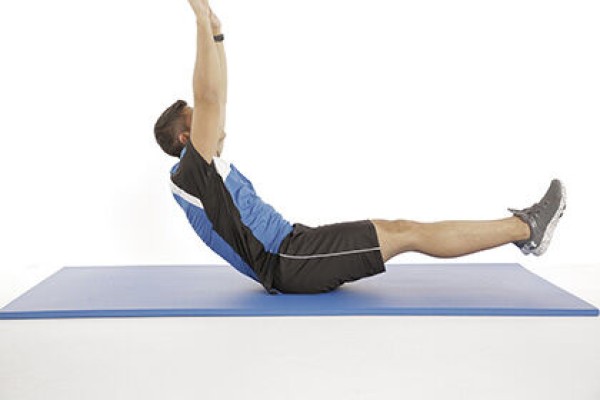
Lying on your back, stretch your legs and arms and lift them off the floor. Alternately rock the body forwards and backwards (raise/lower the shoulder blades), keeping the basic position stable at all times.
Attention:
Keep the body tensed so that rocking is possible. Prevent shoulder and hip movements as much as possible.
Lighten:
Just hold the position with raised arms and legs.
Harden:
Additional weight on the arms and/or legs.
2-4 weight cuffs/2 weight balls/dumbbells ► Make the exercise more difficult (additional weight)
Raise arms and legs in supine position ► hollow hold
Power
Individual work

Lie on your back, arms stretched out and held high, legs also stretched out and slightly raised, tense your stomach and raise your shoulder blades (lift your upper body slightly), hold the position.
Attention:
Do not lower your shoulders, do not hollow your back (pull your belly button towards your spine).
Lighten:
Lift your arms and legs higher.
Harden:
Additional weight on/between the legs (and arms).
2-4 weight cuffs/1-2 weight balls/1 weight disc/dumbbell ► Make the exercise more difficult (additional weight)